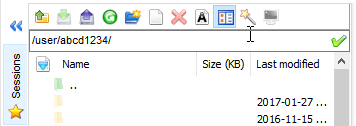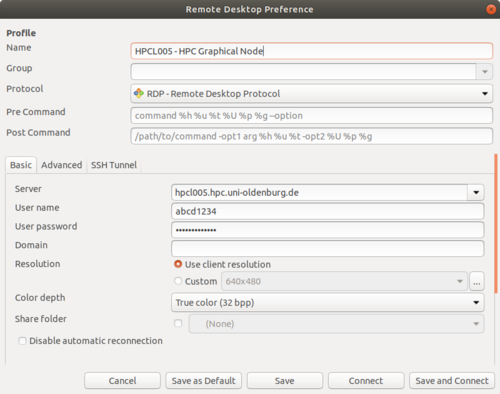Difference between revisions of "Login"
Schwietzer (talk | contribs) |
Schwietzer (talk | contribs) (→Linux) |
||
| Line 145: | Line 145: | ||
You will be prompted for the password on your local machine. If you are using KDE install network-manager-kde instead of the -gnome one. | You will be prompted for the password on your local machine. If you are using KDE install network-manager-kde instead of the -gnome one. | ||
To setup the VPN connection click on the network status (upper left of your desktop) and select VPN connection-->Configure VPN. Now you can either select Add or Import. After selecting "Add", enter the information manually as described in the [ | To setup the VPN connection click on the network status (upper left of your desktop) and select VPN connection-->Configure VPN. Now you can either select Add or Import. After selecting "Add", enter the information manually as described in the [https://uol.de/itdienste/services/netzzugang/vpn-client-fuer-linux/ instructions] of the IT Services. If you want to import the settings, you will need to download the [http://www.itdienste.uni-oldenburg.de/download/download_mit_pwd/VPN_Uni_Oldenburg.pcf PCF-File]. After selecting the option "Import", choose the previously downloaded file. You will now be forced to enter your account credentials. | ||
If, after trying the above, you cannot setup you VPN using the ''Cisco VPN Client'', you can try to install ''openconnect'' with | If, after trying the above, you cannot setup you VPN using the ''Cisco VPN Client'', you can try to install ''openconnect'' with | ||
Revision as of 06:47, 29 July 2019
Login nodes
The cluster provides four login servers that allow you to connect to the cluster (e.g. for submitting and monitoring jobs or editing of files). The login servers can be reached using the hostnames
carl.hpc.uni-oldenburg.de eddy.hpc.uni-oldenburg.de
Using either of the two hostnames will connect you to one of the login servers which have the hostnames
hpcl00[1-4].hpc.uni-oldenburg.de
and are assigned in an round-robin fashion (to distribute the load on the login servers). You can also use these hostname to login to a specific server but should only be used when needed.
Intranet
If you want to connect to the cluster from a windows computer, you can use your favorite ssh client (MobaXterm, PuTTY, OpenSSH, WinSCP) on Windows- and Linux-Computers or the command line (primarily on Linux-computers).
Connect to CARL/EDDY using MobaXterm
"MobaXterm" is the recommend way to connect to the cluster from a Windows computer. The following lines will describe the basic usage of the program.
The newest version of MobaXterm can always be found here: Download
After downloading and installing you are ready to use the program. Once you opened it, click on "Session" in the top left corner. Fill in the following informations:
If you want to connect to EDDY, simply replace "carl" with "eddy" (-> eddy.hpc.uni.oldenburg.de).
As always, replace "abcd1234" with your own username. There are many settings that can be modified, for this example we will not change them though. Confirm by clicking on "OK". A new tab will open and you will be prompted to enter your password.
After typing it in and confirming it with ENTER you are succesfully connected to the cluster.
You will probably immediatly see a big difference to other ssh clients: you can easily browse through the folders on the clusters without using the command line. The sidebar will look like this:
You can even drag&drop files on the cluster with this sidebar, which makes handling files very easy.
Connect to CARL/EDDY using PuTTY
We recommend to use "mobaXterm" since it offers more features and is more user-friendly. Nonetheless its your choise and if you want to use PuTTY you can follow these instructions:
Download the latest version of PuTTY from this link: Download
Enter the url "carl.hpc.uni-oldenburg.de" under the field "Host Name (or IP adress)":
Make sure the Port is set to "22" and the connection type is "SSH". Confirm by pressing the button "Open".
A new windows will popup and you have to type in your username (e.g. "abcd1234):
After you confirmed by pressing ENTER, you will be asked for your password. Type it in and confirm with ENTER again. You are now connected to the cluster.
If you want to connect to EDDY, simply replace "carl" with "eddy" (-> eddy.hpc.uni.oldenburg.de).
If you want to copy files from or on the cluster, you will have to use the program "WinSCP".
Connect to CARL/EDDY using the command line
Users of CARL can connect by typing:
ssh abcd1234@carl.hpc.uni-oldenburg.de
Similarly, users of EDDY login by typing:
ssh abcd1234@eddy.hpc.uni-oldenburg.de
If you want to use graphical applications on the login nodes (e.g. an editor like gedit) you need to enable X-forwarding:
ssh -X abcd1234@carl.hpc.uni-oldenburg.de
Connect to CARL/EDDY using the Remote Desktop Protocol
If you need a graphical user interface (GUI) when using the cluster, and X-forwarding just istn't enought or doesn't perform as needed, there are ways to connect to our cluster with fully enabled GUI support.
Desktop Access via Windows
If the above mentioned approach via X 11 is not sufficient, e.g. because the output is not displayed correctly (FDTD-Solutions...), you can use RDP (Remote Desktop Protocol).
This solution is very straightforward and easy to use. Just look for 'remote desktop' within the start menus search function and select the corresponding program that pops up.
Now, you type into the input mask the following server adress and press enter:
hpcl005.hpc.uni-oldenburg.de
After that, a certificate warning appears which you can ignore. Just confirm that you want to continue anyway. Now you will have to type in your your credentials. Just use the same login data that you would enter when accessing the cluster the usual way. Finally, you will be transmitted to a CentOS desktop environment. If you have ever worked with a virtual linux machine (e.g. VirtualBox, VMWare), this should be familiar to you.
Now, you can start working just like you would on a standard HPC session with the benefit of having a real desktop environment.
As an example, we coud start FDTD-Solutions:
Open a terminal by clicking Applications at the upper left corner and clicking on terminal.
Now you change the environment, load the module and start the program:
module load hpc-env/6.4 module load FDTD-SOLUTIONS fdtd-solutions
After a short while, FDTD-Solutions should pop up with its GUI.
Desktop Access via Linux
If you need a desktop environment for the HPC on your local linux machine, as usual you have the choise between a various of tools, depending on your distribution. Exemplarily, we use the tool remmina which comes natively on a lot of distributions, like Ubuntu. If you can't start remmina natively, you could install it or use a different tool that supports RDP. CentOS users have to use the built in Remote Desktop Viewer Vinagre, for which the usage is quite self-explanatory.
But as mentioned above, we will show you how to start a RDP session via remmina.
Start the tool by opening a terminal and typing in remina. Now you fill in the form as follows:
- Name: The name for the connection is for you to decide.
- Server: This is the login nodes server name.
- User name: The username that you use for every other university service as well.
- User password: The same goes for the password.
- Color Depth: If you get an error message when leavin this on standard, try True colour (32 bpp)
When you finished filling out the mask, click 'Save as Default' and then 'Save and Connect'. Now you will directed to the node. You may have to enter your credentials again, but after that you are good to go!
With this method, there are two things to be aware of!
- Save System Ressources!
- hpcl005 is a login node with very few ressources. So please don't do heavy computing on this node! That's what our queue system (SLURM) and our computing nodes are for. hpcl005 is made for users who are dependent on a graphical interface and is designed for short testing sequences.
- Log out!
- When you've finished testing on hpcl005, please quit your programs within the terminal and finally log out of the graphic node. You can do this by clicking the 'power button' on the upper right corner and selecting your name which is displayed on the menu. Now you should see a Log Out option.
Internet
First, you have to establish a VPN tunnel to the university intranet. After that, you can login to CARL or EDDY via ssh as described above. See the following instructions on how to setup the VPN tunnel:
Windows
Download the Cisco-VPN-Client from this web site and install it following the instructions of the IT Services.
When you start a VPN tunnel by pressing connect, you will be prompted for your university user name and password.
Linux
First you may need to install some additional packages. This can be done e.g. with the command:
sudo apt-get install network-manager network-manager-gnome network-manager-vpnc vpnc
You will be prompted for the password on your local machine. If you are using KDE install network-manager-kde instead of the -gnome one.
To setup the VPN connection click on the network status (upper left of your desktop) and select VPN connection-->Configure VPN. Now you can either select Add or Import. After selecting "Add", enter the information manually as described in the instructions of the IT Services. If you want to import the settings, you will need to download the PCF-File. After selecting the option "Import", choose the previously downloaded file. You will now be forced to enter your account credentials.
If, after trying the above, you cannot setup you VPN using the Cisco VPN Client, you can try to install openconnect with
sudo apt-get install network-manager-openconnect-gnome
After that, proceed as before and select the Cisco AnyConnect Comaptible VPN. In this configuration, you only need to enter your username and password to conncet.
To connect click on the network status again and select the VPN connection you just configured.




